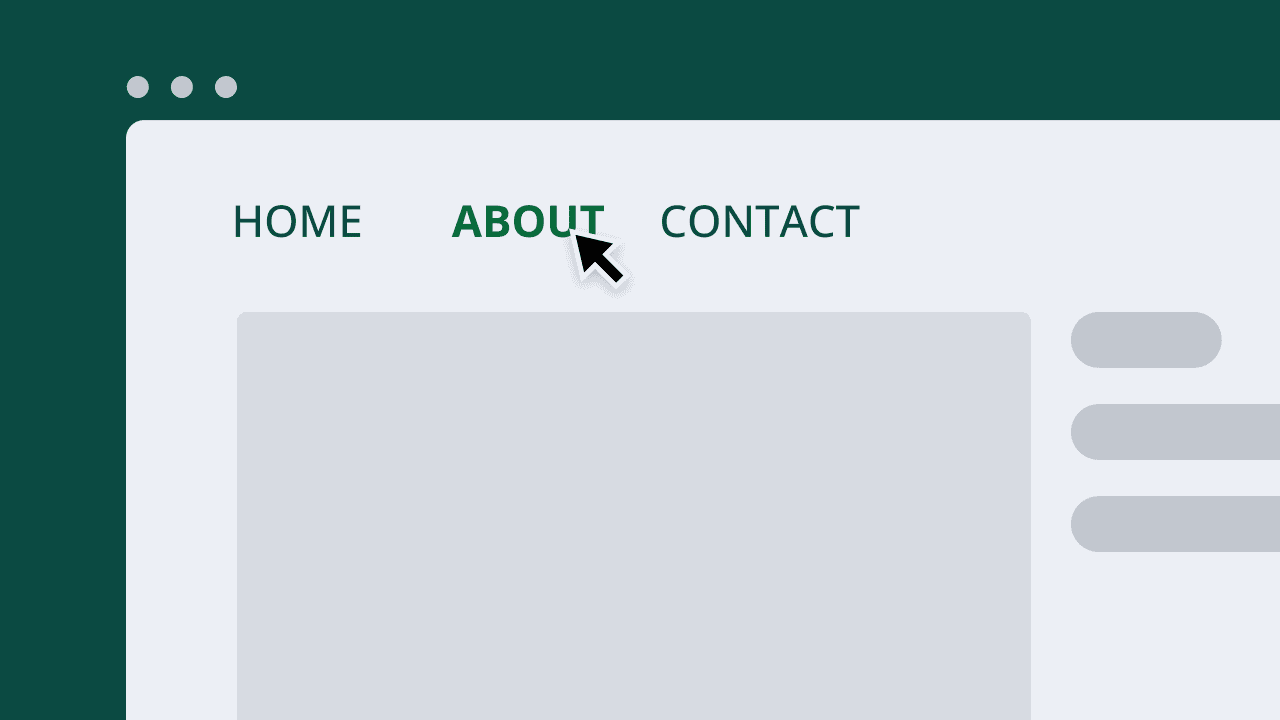Key takeaways:
- Every strong personal website should include a home page, about page, portfolio, contact page, and resume/CV.
- A personal website is a place online where you can show who you are, what you do, and how people can contact or work with you.
- A good personal website is clear, compelling and personal. Make sure it reflects how you want to be seen by the world.
Wondering what pages should I have on my personal website? Every strong personal website should include five essentials: a home page, about page, portfolio, contact page, and resume/CV. From there, you can add optional pages depending on your goals.
But if that’s all you need to know for a successful personal website, then everyone would have one by now. So, what else are you missing?
Let’s explore what pages and information to include in your personal site, how those pages can help you, and how to start creating them. Then, let’s study other personal websites and break down what made them successful.
What is a personal website?
A personal website is a platform where you can showcase who you are, what you do, and how people can contact or work with you. Unlike social media platforms, where algorithms or platform rules can limit visibility, your website is 100% yours. You control the content, design, and functionality.
Think of it as:
- Your digital resume that never goes out of date
- Your portfolio that’s always accessible online
- Your personal homepage where people get the best version of you
Personal website vs. professional website
How does a personal website differ from a professional one anyway? Here’s a clear side-by-side table comparing both:
| Aspect | Professional website | Personal website |
| Purpose | To promote a business, brand, or service | To showcase personal projects, achievements, and interests |
| Tone | Formal, polished, business-oriented | Casual, expressive, and reflective of personal style |
| Audience | Clients, customers, business partners, investors | Friends, followers, potential clients and employers, collaborators |
| Content Focus | Services/products, case studies, portfolio, client testimonials, company info | Personal projects, blog posts, portfolio (if applicable), resume/CV, hobbies |
| Design | Structured, clean, and aligned with branding | Flexible, creative, with more room for individuality |
| Goal | Build credibility, attract clients/customers, generate leads or sales | Share personal journey, create a digital presence, showcase hobbies or creative work |
| Example | Company website, eCommerce store, consulting firm site | Freelance designer portfolio, writer’s blog, personal resume page |
| Call to Action | “Contact us,” “Shop now,” “Request a quote” | “Read more,” “See my work,” “Contact me” |
| Features | Service listings, pricing, contact forms, testimonials, product showcases | Blog, gallery, about section, personal achievements, resume/CV |
Essentially, a professional website is for businesses or professionals looking to promote their offerings. It’s formal, focused on attracting customers or clients, and includes information like services, products, and client testimonials.
A personal website showcases an individual’s work, projects, and interests. It’s more casual and reflects the person’s personality, and it often includes a blog, portfolio, or resume.
While a professional website aims to build a business’s credibility, a personal website is more about showcasing your identity and sharing individual ideas.
Why do you need a personal website?
Most professionals use traditional resumes and portfolios or post on LinkedIn to get noticed by recruiters or potential employers. Creating a website may also be a more costly investment for the average person, not to mention the added responsibility of managing it.
So why build a professional website? Here are a few good reasons:
- Narrative control. Instead of being boxed into the same template as everyone else on LinkedIn or a portfolio site, you decide how your skills, projects, and personality are presented. That control lets you highlight what really matters to your audience.
- Professional credibility. A clean, well-structured website shows seriousness and attention to detail. Employers and clients often see it as a sign that you’re invested in your craft and proactive about your personal brand.
- Discoverability. When someone Googles your name, your website can rank at the top of the search engine results pages (SERPs). That means anyone can see the official version of you that you want them to see, not just scattered social profiles.
- Constant accessibility. A personal website works around the clock. Unlike a resume you email to a single person, your site can reach anyone, anywhere, at any time. It’s a 24/7 introduction that doesn’t require you to be in the room.
- Growth flexibility. Your career can evolve, and so can your site. You might start with a simple resume and portfolio, then later add a blog, services, or media features as opportunities expand. A personal website is a long-term asset that grows alongside you.
What should be on my personal website?
Before you can get into creating your own website, planning your website content and structure helps make the process easier. Let’s go over all the important pages it needs first.
- Home page
- About page
- Portfolio or work examples
- Contact page
- Resume or CV
Home page
Your homepage is the first thing people see, so it should clearly answer: Who are you, what do you do, and why should someone care?
In just a few seconds, website visitors decide whether they’ll stick around or leave. The easiest way to keep them is to have an appealing homepage that welcomes them right away.
Tips for a strong homepage:
- A headline that sums up your professional value.
- A short intro paragraph with your expertise.
- A professional photo for trust and personality.
- Clear CTAs (see my work, contact me, download resume).
For example, instead of “Welcome to my website,” you might write, “I’m a UX designer helping startups create mobile experiences that people actually enjoy.” Pair this with a professional photo, a simple call to action like “See my work” or “Download my resume,” and you’ve already given visitors everything they need to move forward.
A home page doesn’t need to say everything about you—it just needs to open the door.
About page
The About page is often the second-most visited page. This is where you give people the context behind your work.
Instead of writing a dry bio, make it personal:
- Share your career journey and milestones.
- Explain your values, motivations, and goals.
- Talk about the problems you’re passionate about solving.
- Add a photo or even testimonials for credibility.
You might explain how a background in journalism makes you a sharper marketer, or how a love of gaming sparked your interest in design. Adding a photo helps humanize the page, and sprinkling in a testimonial or two adds credibility. The key is to make visitors feel like they know you—not just as a list of job titles, but as a person they’d want to work with.
Portfolio or work examples
Your portfolio is where you move from telling to showing. This is where you demonstrate not just what you’ve done, but how you think and what results you’ve achieved.
Best practices:
- Show 3 to 6 of your best projects.
- Explain your role, the challenge, and the outcome.
- Use visuals like images, graphs, screenshots when possible.
If you’re a designer, that might mean showing sketches, mockups, and final screens. If you’re a freelance writer, you might link to published articles and explain the audience they reached. If you’re in a less visual field, case studies work beautifully: outline the problem, your approach, and the measurable results.
Framing each project as a story makes your work more memorable and persuasive.
Contact page
A personal website isn’t much use if people can’t figure out how to contact you. Your contact page should make the process straightforward and inviting.
- Add your contact details.
- Include a form to reduce spam.
- List email, LinkedIn, or other relevant links.
- Set expectations: “I reply within 48 hours.”
A contact page goes beyond function. You want your tone to feel approachable, so potential clients and customers actually try to communicate with you.
Resume or CV page
Most people still expect to see a resume when they’re considering someone for a role or project. But on your website, you can do more than upload a PDF—you can create a resume that’s interactive and link-rich.
A web-based resume can:
- Link directly to portfolio projects.
- Highlight skills, education, achievements.
- Offer a downloadable version for convenience.
This approach shows that you’ve put thought into how you present yourself, and it makes life easier for recruiters or clients who want to understand your career at a glance.
Optional pages that add extra value
Once you’ve built the core five pages, you can take your website further by adding optional sections that deepen credibility, improve discoverability, or support your business goals. These pages aren’t necessary for everyone, but when used strategically, they can set your website apart and make it a more powerful tool.
- Blog page. A personal blog shows how you think and what you know. Publishing articles, tutorials, or reflections can position you as an expert and help people understand your process. Blogs also improve your search engine optimization (SEO), giving you more chances to be discovered for your skills and insights. Just posting once a month can add depth to your professional story.
- Testimonials. Social proof builds trust faster than self-promotion ever can. A testimonials page, or even a few quotes sprinkled across your site, lets previous colleagues, satisfied clients, or trusted mentors highlight your strengths and results. These work best when they’re specific—mentioning outcomes, qualities, or measurable impact. A strong testimonial reassures visitors that others have worked with you and walked away impressed.
- Services. If you freelance, consult, or sell expertise, a services page makes your offerings clear. It should outline what you do, who it’s for, and the outcomes people can expect. Instead of simply listing “web design,” explain that you “design fast, mobile-friendly websites that help small businesses attract more customers.” This page turns your site into a business tool by guiding people toward hiring you.
- Press/Media mentions. Being featured in an article, podcast, or event adds third-party credibility to your name. A dedicated press page can showcase these mentions with links, logos, and short descriptions. Even small features signal that your work is noteworthy, while more prominent coverage builds authority in your industry. Over time, this page becomes a living portfolio of external recognition.
- Free resources/Downloads. Offering free tools or guides helps you provide immediate value. Think of things like templates, checklists, or how-to guides that your audience would find useful. These resources showcase your expertise while also building trust, since people see you as someone who helps first. They can also double as lead magnets if you decide to grow an email list later.
Essential vs optional pages for your personal website
| Page | Priority | Best for |
| Home | Must-have | Everyone |
| About | Must-have | Everyone |
| Portfolio | Must-have | Freelancers, creatives |
| Contact | Must-have | Everyone |
| Resume/CV | Must-have | Job seekers, career changers |
| Blog | Optional | Writers, consultants |
| Testimonials | Optional | Freelancers, service providers |
| Services | Optional | Consultants, coaches |
| Media/Press | Optional | Public figures, speakers |
What does a good personal website look like?
A good personal website is:
- Clear. It has simple navigation and it’s easy to understand.
- Professional. It has strong visuals and consistent branding.
- Personal. It shows your personality, not just credentials.
For example:
- A designer can highlight projects with case studies.
- A writer could showcase published work and link to blogs.
- A consultant might focus on testimonials and services.
6 compelling personal website examples from real professionals
With the basic concepts of a strong personal website, it’s time to analyze how they’re put into practice. Check these six personal website examples and see why they’re successful:
1. Peter McKinnon (photographer and video creator)
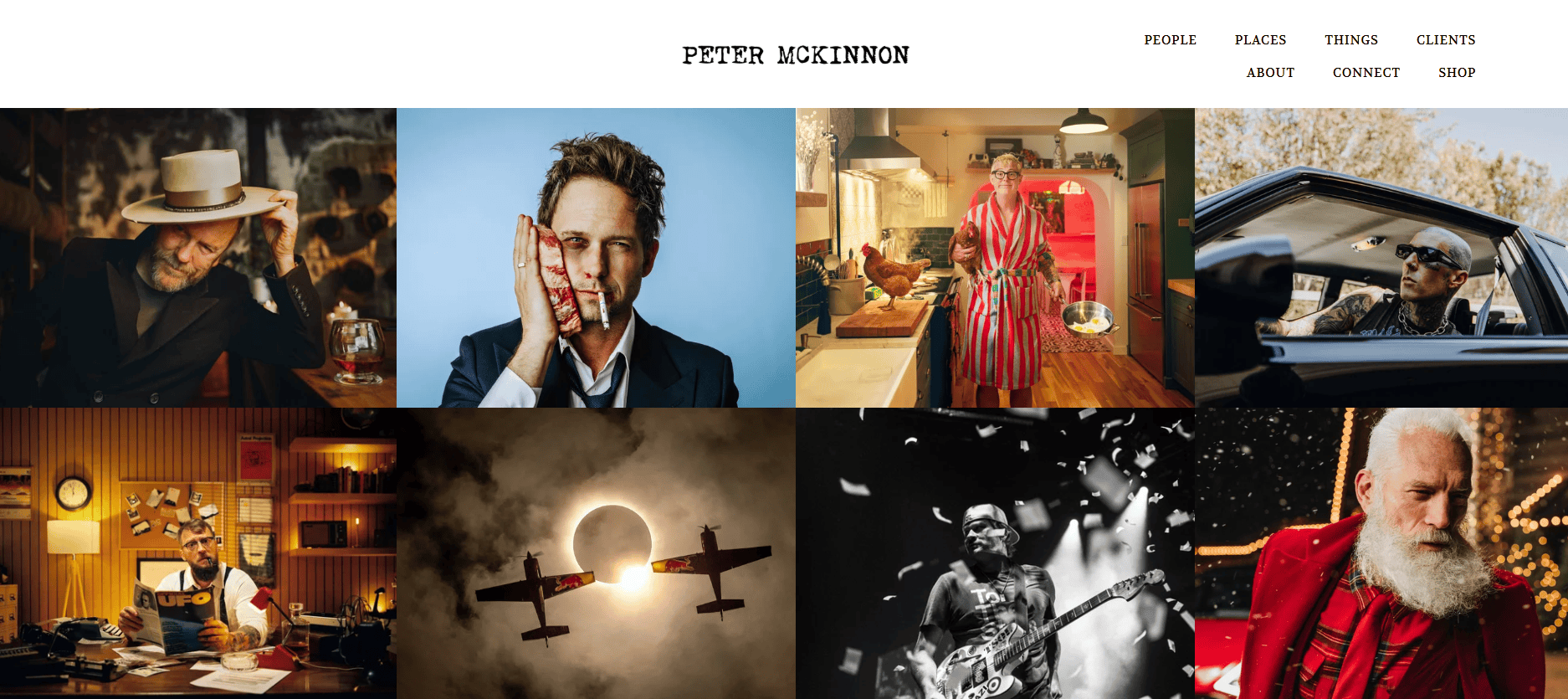
Peter McKinnon’s website, petermckinnon.com, is the online hub for the internationally recognized photographer, filmmaker, and entrepreneur. The site serves as a portfolio of his work, a blog, and an eCommerce platform where he sells his products like lens filters and lightroom presets.
What makes it stand out: Heroic visual collage with parallax effects; minimalist navigation focused only on social icons.
Takeaway: Lead with powerful visuals and reduce menu clutter to keep attention on your work.
2. Lin-Manuel Miranda (author and performer)
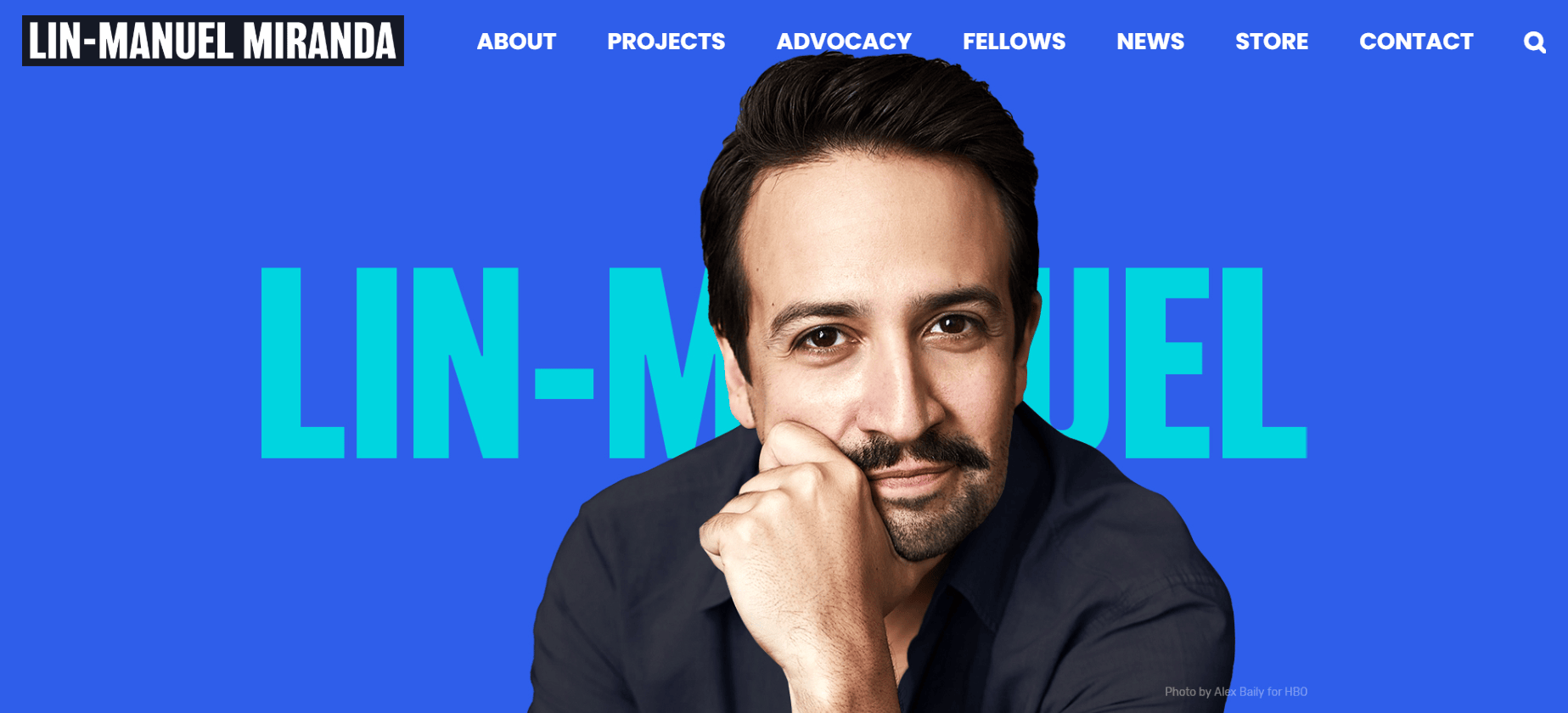
Lin-Manuel Miranda’s official website, linmanuel.com, serves as a central hub for his extensive creative work. The homepage highlights his various projects, including musicals like “Hamilton” and “In the Heights,” and his work on animated films such as “Encanto” and “Moana.” You can also read information about the Miranda Family Fellows and provides links to his music on streaming platforms. The website offers sections for news, contact information for press and philanthropy, and details on how fans can connect.
What makes it stand out: Full-screen hero image, interactive effects, and back-to-top functionality for long pages.
Takeaway: Combine immersive design with helpful navigation features to guide visitors and keep users engaged.
3. Arlen McCluskey (designer)
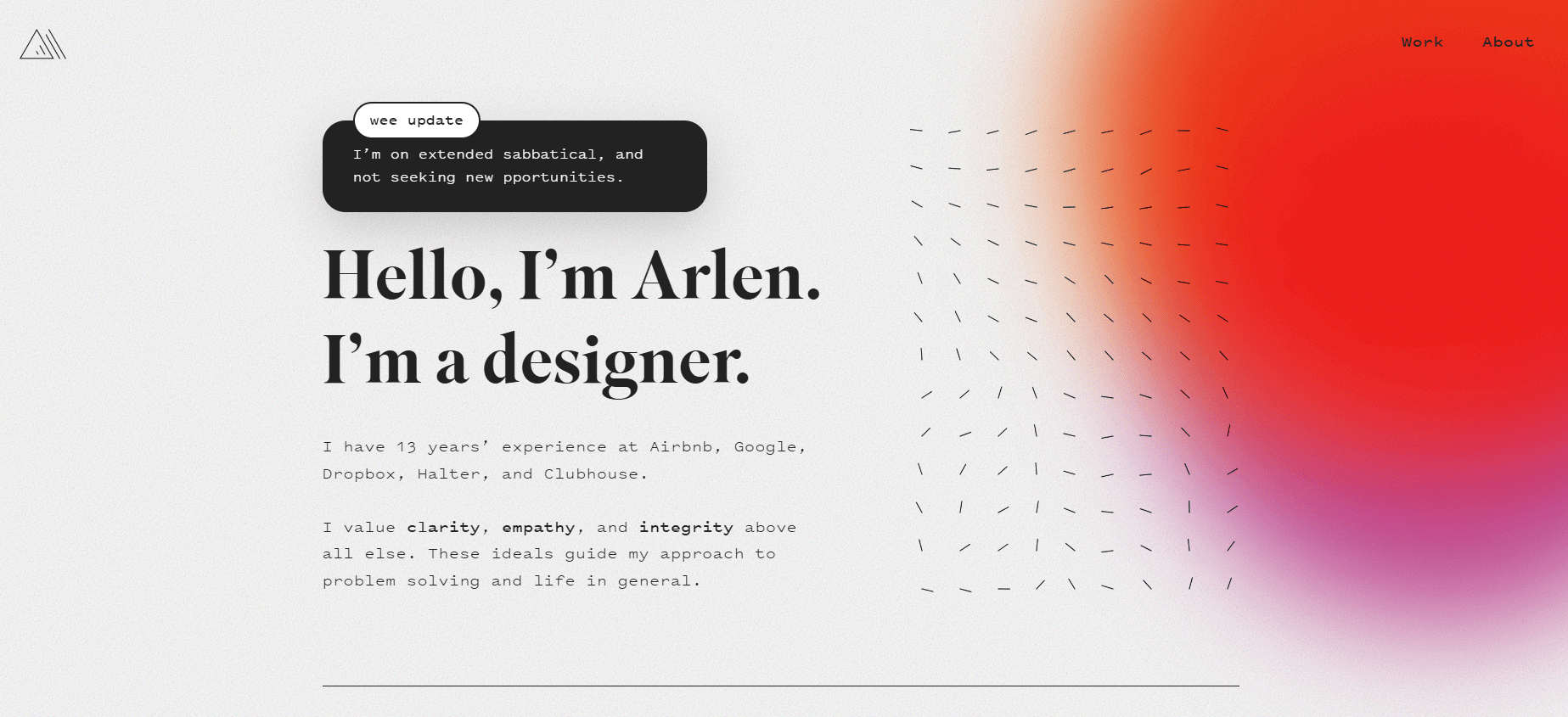
Arlen McCluskey is a highly experienced and respected product designer with over 13 years of experience at prominent tech companies such as Airbnb, Google, Dropbox, Halter, and Clubhouse. His work focuses on creating clear, empathetic, and integral user experiences. His website, arlenmccluskey.com, stands out as an excellent example of a product design portfolio that effectively showcases his expertise and work.
What makes it stand out: Clean layout with distinct sections showcasing projects; straightforward footer.
Takeaway: Structure your site simply yet creatively to emphasize clarity and elegance.
4. Joe Coleman (artist)
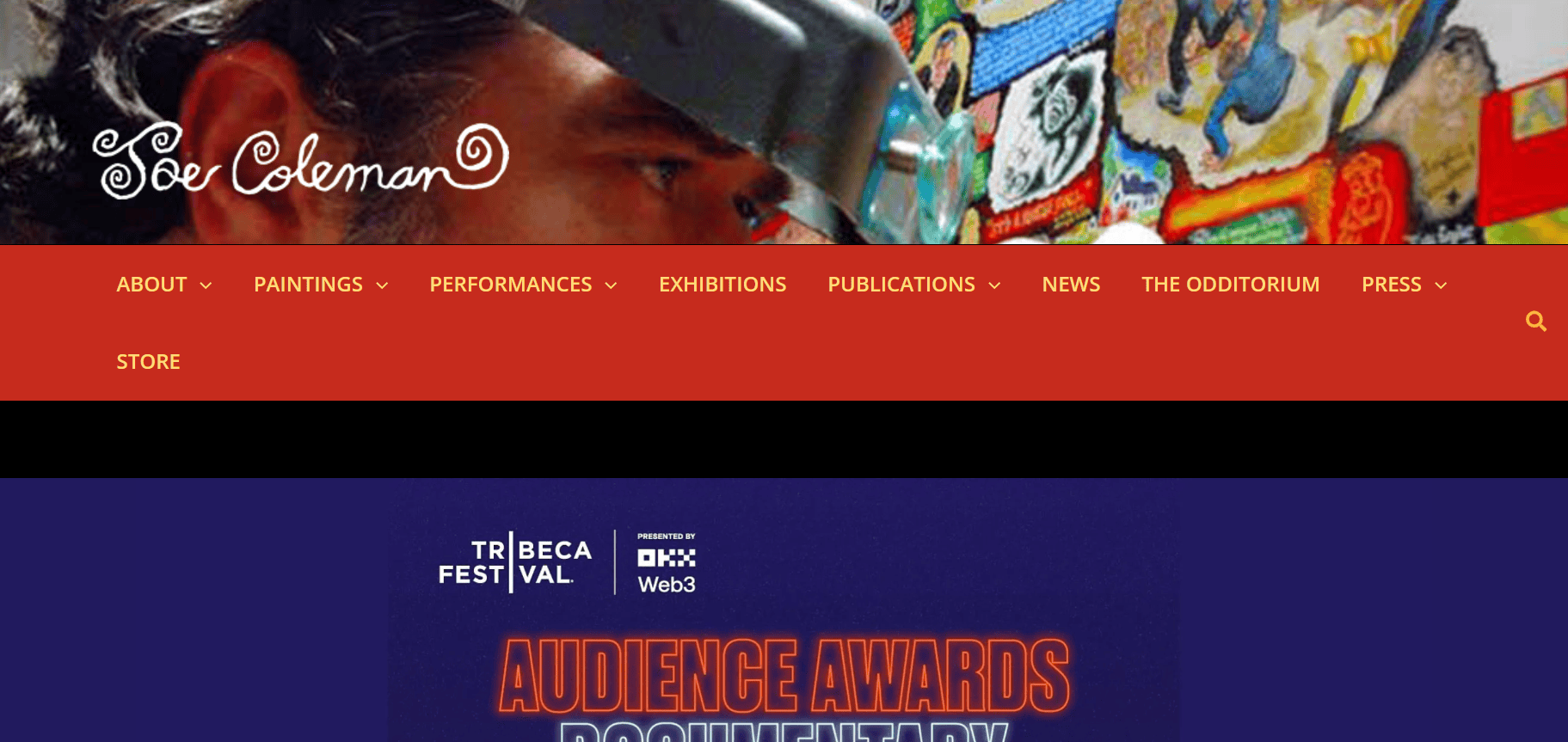
Joe Coleman is a world-renowned painter, writer, and performance artist known for his highly detailed and meticulous artwork. His paintings are so intricate that he often uses jeweler’s lenses and a single-hair brush, with some works taking years to complete.
His website, joecoleman.com, serves as a comprehensive digital archive and showcase of his career. The site is a central hub for his diverse artistic output, organized into distinct sections that make his complex body of work easy to navigate.
What makes it stand out: Compelling homepage with multiple tone options for the bio—from humorous to serious.
Takeaway: Experiment with tone and invite your audience to choose the version that speaks to them.
5. Bruno Simon (web developer / 3D interactive designer)

Bruno Simon is a highly regarded creative developer based in Paris, known for his expertise in WebGL and creating unique, interactive 3D web experiences. He’s also a teacher in web development and a freelancer, having previously held lead developer roles at Immersive Garden and Uzik.
His website, bruno-simon.com, is an exceptional example of an interactive portfolio that fully embodies his skills as a creative developer specializing in 3D web experiences. Just one look at it immediately showcases his talents and niche.
Why it stands out: His site is an immersive, playful 3D world where visitors drive a mini car through his portfolio—demonstrating his interactive design prowess from the very first interaction.
Takeaway: Use unique and interactive elements to showcase your expertise and engage visitors from the start.
6. Tobias Becs (football freestyler)
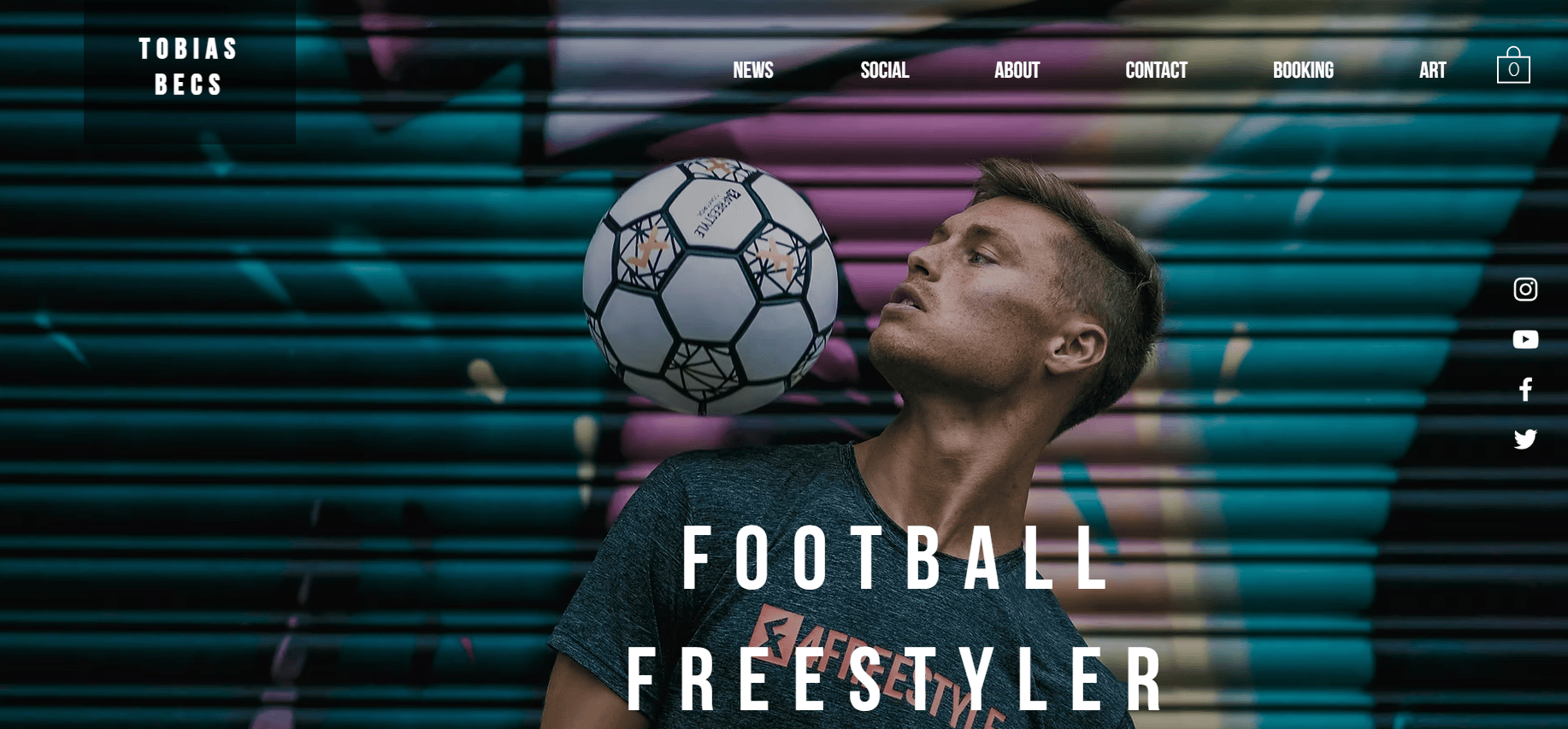
Tobias Becs is a world-renowned football freestyler, entrepreneur, and content creator. He has won numerous accolades, including becoming a world champion, European champion, and a Guinness World Record holder. Beyond his athletic achievements, he is also an award-winning content creator, a global ambassador for UEFA, and a consultant for major brands and football clubs.
His website, tobiasbecs.com, serves as a professional platform to showcase his diverse skills and the services he offers. The site is primarily a booking and portfolio tool for his various ventures.
What makes it stand out: Bold opening photo with instant achievements and credibility indicated at a glance.
Takeaway: If achievements define you, showcase them prominently in your hero section.
| Professional | What makes it stand out | Takeaway |
| Peter McKinnon — Photographer & Video Creator | Heroic visual collage with parallax effects; minimalist navigation focused only on social icons | Lead with powerful visuals and reduce menu clutter to keep attention on your work. |
| Lin-Manuel Miranda — Author & Performer | Full-screen hero image; interactive effects; back-to-top functionality for long pages | Combine immersive design with helpful navigation features to guide visitors and keep users engaged. |
| Arlen McCluskey — Designer | Clean layout with distinct sections showcasing projects; straightforward footer | Structure your site simply yet creatively to emphasize clarity and elegance. |
| Joe Coleman — Copywriter | Compelling homepage with multiple tone options for the bio—from humorous to serious | Experiment with tone and invite your audience to choose the version that speaks to them. |
| Kelsey O’Halloran — Copy & Brand Messaging Consultant | Clean design, great copy, cohesive branding, visible CTAs, and strong client testimonials | Align design with messaging and social proof to build trust and showcase professionalism. |
| Bruno Simon — Web Developer / 3D Interactive Designer | Immersive, playful 3D world where visitors drive a mini car through his portfolio, demonstrating interactive design skills | Use unique and interactive elements to showcase your expertise and engage visitors from the start. |
| Tobias Becs — Football Freestyler | Bold opening photo with instant achievements and credibility highlighted at a glance | If achievements define you, showcase them prominently in your hero section. |
These examples demonstrate how thoughtful structuring, strong personal branding, and selective use of multimedia can elevate a personal website. By combining a clear message with compelling visuals and intuitive navigation, you can create a site that leaves a memorable – and most importantly, human — impression.
How to create your personal website
You’re ready to build your own personal site. Here’s a quick rundown on what you’ll need to do:
- Define your purpose and target audience.
- Register a domain name.
- Choose a website builder.
- Select a web host.
- Create your core pages.
- Design for mobile-first, clean navigation, and speed.
- Apply basic SEO.
- Launch, promote, and update regularly.
Let’s dive into the steps in more detail:
1. Define your purpose and target audience.
Before you start building your website, it’s important to understand who you’re designing it for and what you want to achieve. Are you showcasing a portfolio, promoting a service, or building a personal blog? Identifying your target audience will help guide your content, design, and overall approach.
2. Register a domain name.
Your domain name is your website’s address on the internet, so choose something short, memorable, and relevant to your personal brand. Ideally, it should match your name like petermckinnon.com. Make sure it’s easy to spell and doesn’t confuse potential visitors.
3. Choose a website builder.
A website builder makes site development easy. You don’t need to code since most offer AI tools and drag-and-drop functionalities. It’s perfect if you’re a busy professional without starting from scratch. Ensure it provides customizable templates, drag-and-drop features, and easy integration with other tools, such as social media or analytics.
Popular website builders such as Network Solutions offer domains as part of the website builder package, plus some more like professional emails and SSL certificates.
4. Select a web host.
A web host stores your website’s files and makes them accessible online. Choose a reliable hosting provider that offers fast loading times, solid customer support, and security features. Many website builders include hosting, but if you’re using a self-hosted platform like WordPress, you’ll need to pick a host separately.
5. Create your core pages.
Start by setting up the key pages for your website. The Home page introduces you to visitors, the About page tells your story, the Portfolio showcases your work, the Contact page makes it easy to reach you, and the Resume page highlights your professional background.
6. Design for mobile-first, clean navigation, and speed.
Since many users browse on mobile devices, ensure your website is optimized for smaller screens. Focus on having clean, simple navigation, fast loading times, and easy-to-read text. A fast, responsive design improves user experience and SEO rankings.
7. Apply basic SEO.
Optimize your website for search engines by using relevant keywords, writing clear meta descriptions, and adding descriptive titles to each page. This helps search engines understand what your site is about and improves your chances of being found by your target audience.
8. Launch, promote, and update regularly.
Once your site is live, promote it by sharing it across your social media channels, email signature, and other networks. Regularly update the site with new content, portfolio pieces, or blog posts to keep it fresh and maintain visibility.
Common personal website mistakes to avoid
You’re almost ready to launch your website. Let’s just lay down a few quick reminders of what to avoid:
- Complicated menus that overwhelm visitors. If your navigation is too complex or has too many options, visitors may feel lost and unable to quickly find what they’re looking for. Keep the menu simple with clear categories to guide users seamlessly through your site.
- Using low-quality or outdated images. Low-resolution or outdated images can make your site look unprofessional. Always use high-quality, current visuals that align with your personal brand, and update your images regularly to keep your site fresh and engaging.
- Letting content sit stale for months. An inactive website, with outdated or irrelevant content, can give the impression that you’re no longer engaged with your own brand. Regularly refresh your content, whether it’s through blog posts, portfolio updates, or keeping your résumé current.
- Making it hard to contact you. If visitors can’t easily find how to get in touch, they’ll likely leave without reaching out. Ensure your contact information or forms are accessible from any page and clearly outline how to connect with you—whether it’s through email, social media, or a contact form.
- Inconsistent fonts, colors, or tone. An inconsistent design or mismatched tone can confuse visitors and undermine your professionalism. Make sure your website has a consistent visual style and a unified tone of voice that reflects your personality or brand, creating a cohesive and trustworthy experience.
Launch your personal website with ease
Launching your personal website can feel like a big task, but it doesn’t have to be complicated. By focusing on the basics, you’ll create a website that works for you.
Remember, your site doesn’t have to be perfect right away. Start with what you need and build from there. Once it’s live, you’ll have a space to showcase your work, share your story, and connect with the people who matter most.
So, go ahead—launch your website with confidence. Let Network Solutions’ DIY Website Builder assist you in taking the next step of building your personal brand. Or you can let professional web developers do the heavy lifting.

Frequently asked questions
Your personal website should include a home page, about page, portfolio, contact page, and resume. These pages provide a comprehensive overview of who you are, what you do, and how potential employers, clients, or collaborators can contact you. Depending on your personal brand, you might also want to add a blog, testimonials, services, or a press page to further engage with your audience and boost credibility.
Most personal websites typically have 4 to 5 core pages, with optional extras added depending on your goals.
A good personal website is clean, easy to navigate, and professional, while still reflecting your personality and skills. It should be designed with your audience in mind, offering a seamless user experience. Visual consistency, fast load times, and intuitive navigation are key elements, making sure that your website is not only attractive but also functional and accessible on all devices.
The seven key elements that contribute to a successful online presence are:
1. Clarity (clear messaging)
2. Content (relevant and valuable information)
3. Consistency (design and tone across pages)
4. Credibility (trust-building features like testimonials)
5. Customer-centric (user-focused experience)
6. Communication (clear calls to action)
7. Conversion (guiding users toward desired actions like filling out a contact form or making a purchase)
By focusing on these principles, your website will better meet the needs of your visitors and achieve your goals
